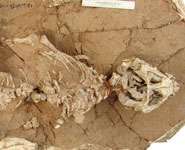What's in a dinosaur name?

(PhysOrg.com) -- A new species of dinosaur is named somewhere in the world every two weeks. But are they all new species, or do the newly-discovered bones really belong to a dinosaur already identified?
Biologists have long been aware of the ‘alias problem’ which refers to the number of times when one species has been given more than one name. Recent studies on dinosaurs have shown that the error rate may be as high as 50 per cent.
In a study published today in Biology Letters, Professor Michael Benton of the Department of Earth Sciences at the University of Bristol looked at the original descriptions of all 1,047 species of dinosaurs ever named, from 1824 to the present day, and assessed the quality of the specimens on which the names were founded – the type specimens.
Professor Benton said: “The bane of the dinosaurologist’s life is species that have been named on the basis of incomplete specimens. In Victorian times, palaeontologists were keen to name new species, and in the excitement of the great ‘bone wars’ for example, from 1870 to 1890, they rushed into print with new names for every odd leg bone, tooth, or skull cap that came their way. Later work, on more complete specimens, reduced more than 1000 named dinosaurs to 500 or so.”
Professor Benton’s new research shows that although the ‘error rate’ in naming dinosaurs has been high in the past, scientific practice has improved enormously in recent years. This means that in fact most new dinosaur species announced today are likely to be correctly named.
Up to 1960, more than half of all new species were based on scrappy type specimens. But since 1960, the great majority of new species are founded on more or less complete specimens, sometimes even whole skeletons.
“This means that most of the new species will probably survive scrutiny,” said Professor Benton. “It’s not often you can demonstrate a real improvement in scientific practice, but this is one case we can be grateful for.”
Provided by University of Bristol
















